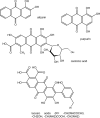Microanalysis of organic pigments and glazes in polychrome works of art by surface-enhanced resonance Raman scattering
- PMID: 19667181
- PMCID: PMC2736431
- DOI: 10.1073/pnas.0906995106
Microanalysis of organic pigments and glazes in polychrome works of art by surface-enhanced resonance Raman scattering
Abstract
Scientific studies of works of art are usually limited by severe sampling restrictions. The identification of organic colorants, a class of compounds relevant for attribution and provenance studies, is further complicated by the low concentrations at which these compounds are used and by the interference of the protein-, gum-, or oil-binding media present in pigment and glaze samples. Surface-enhanced resonance Raman scattering (SERRS) was successfully used to identify natural organic colorants in archaeological objects, polychrome sculptures, and paintings from samples smaller than 25 microm in diameter. The key factors in achieving the necessary sensitivity were a highly active stabilized silver colloid, obtained by the reproducible microwave-supported reduction of silver sulfate with glucose and sodium citrate, and a non-extractive hydrolysis sample treatment procedure that maximizes dye adsorption on the colloid. Among the examples presented are the earliest so far found occurrence of madder lake (in a 4,000 years old Egyptian object dating to the Middle Kingdom period), and the earliest known occurrence in Europe of the South Asian dyestuff lac (in the Morgan Madonna, a 12th century polychrome sculpture from Auvergne, France).
Conflict of interest statement
The author declares no conflict of interest.
Figures




Comment in
-
An improved method for identifying red lakes on art and historical artifacts.Proc Natl Acad Sci U S A. 2009 Sep 8;106(36):15095-6. doi: 10.1073/pnas.0907727106. Epub 2009 Sep 1. Proc Natl Acad Sci U S A. 2009. PMID: 19805243 Free PMC article. No abstract available.
References
-
- Hofenk de Graaff JH. The Colourful Past. London: Abegg-Stiftung, Riggisberg, and Archetype; 2004.
-
- Schweppe H, Winter J. In: Artists' Pigments: A Handbook of Their History and Characteristics. West Fitzhugh E, editor. Vol 3. Washington DC: National Gallery of Art; 1997. pp. 109–142.
-
- Schweppe H, Roosen-Runge H. In: Artists' Pigments: A Handbook of Their History and Characteristics. Feller RL, editor. Vol 1. Washington DC: National Gallery of Art; 1986. pp. 255–283.
-
- Leona M, Winter J. Fiber optics reflectance spectroscopy: A unique tool for the investigation of Japanese paintings. Stud Conserv. 2001;46:153–162.
-
- Smith G, Clark RJH. Raman microscopy in art history and conservation science. Rev Conserv. 2001;2:96–106.
Publication types
MeSH terms
Substances
LinkOut - more resources
Full Text Sources

